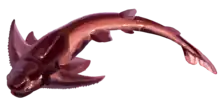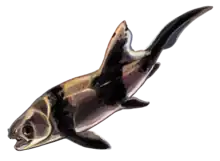Heterosteidae
Heterosteidae (also known as Heterostiidae[1][2]) is an extinct family of moderately large to giant, flattened, benthic arthrodire placoderms with distinctive, flattened, triangular skulls that are extremely broad posteriorly, but become very narrow anteriorly.[3]
| Heterosteidae | |
|---|---|
 | |
| Comparison of genera | |
| Scientific classification | |
| Domain: | Eukaryota |
| Kingdom: | Animalia |
| Phylum: | Chordata |
| Class: | †Placodermi |
| Order: | †Arthrodira |
| Suborder: | †Brachythoraci |
| Clade: | †Eubrachythoraci |
| Clade: | †Pachyosteomorphi |
| Superfamily: | †Dunkleosteoidea |
| Family: | †Heterosteidae Jaekel, 1903 |
| Genera | |
Heterosteidae belongs to the superfamily Dunkleosteoidea, a relative of the giant Dunkleosteus, as shown in the cladogram below:[1]
| Dunkleosteoidea |
| ||||||||||||||||||||||||||||||||||||||||||||||||||||||
References
- Zhu, You-An; Zhu, Min; Wang, Jun-Qing (1 April 2016). "Redescription of Yinostius major (Arthrodira: Heterostiidae) from the Lower Devonian of China, and the interrelationships of Brachythoraci". Zoological Journal of the Linnean Society. 176 (4): 806–834. doi:10.1111/zoj.12356. ISSN 0024-4082.
- Schultze, Hans-Peter; Cumbaa, Stephen L. (26 April 2017). "A new Early Devonian (Emsian) arthrodire from the Northwest Territories, Canada, and its significance for paleogeographic reconstruction". Canadian Journal of Earth Sciences. 54 (5): 461–476. Bibcode:2017CaJES..54..461S. doi:10.1139/cjes-2017-0013. hdl:1807/76893.
- Denison, Robert (1978). Placodermi Volume 2 of Handbook of Paleoichthyology. Stuttgart New York: Gustav Fischer Verlag. p. 65. ISBN 978-0-89574-027-4.
This article is issued from Wikipedia. The text is licensed under Creative Commons - Attribution - Sharealike. Additional terms may apply for the media files.







